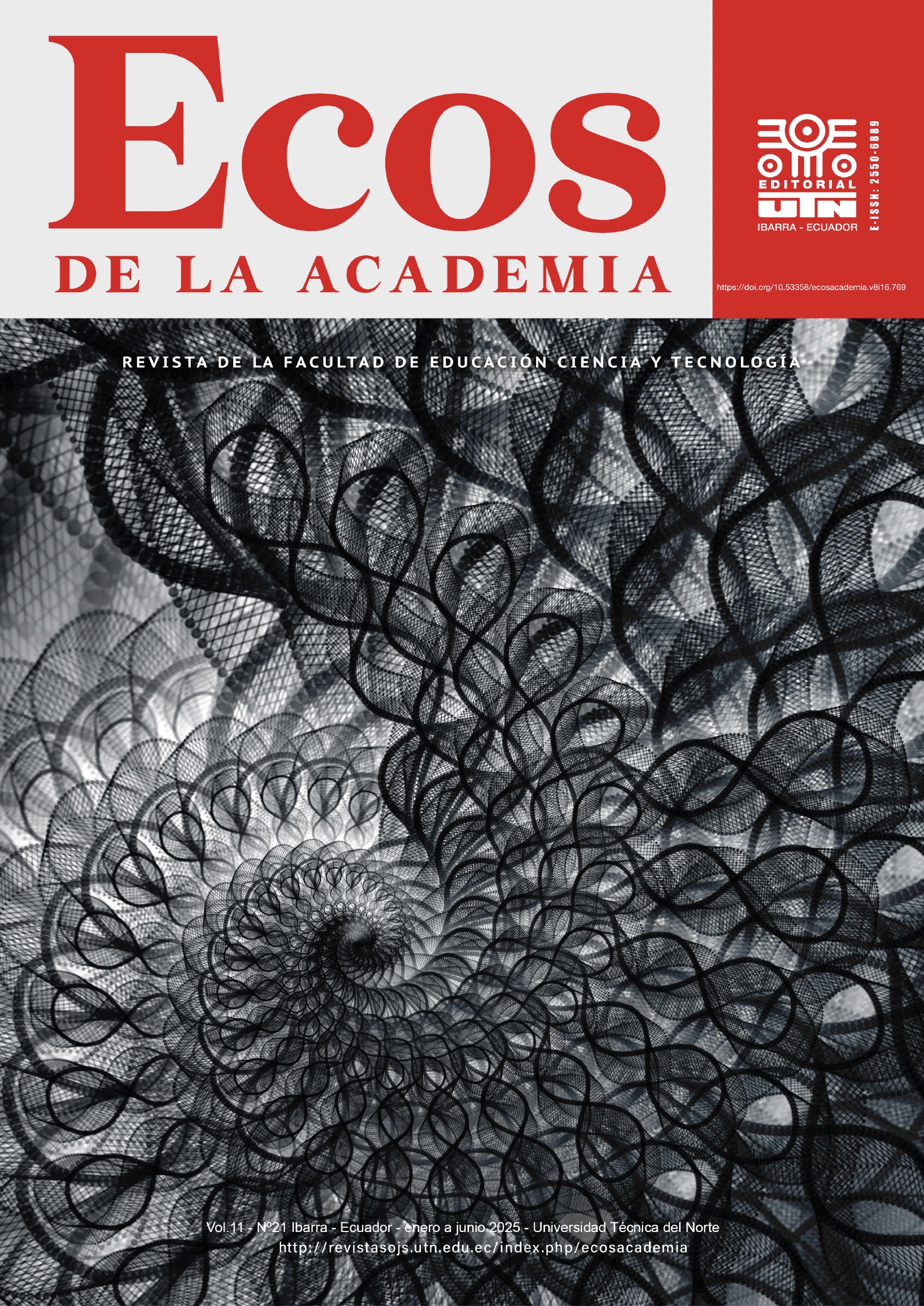Comparison of Flight Time Based on Jump Amplitude in the 540° Back-Turn Technique in Taekwondo Técnica de giro hacia atrás en Taekwondo
Main Article Content
Abstract
The study addressesed the need to optimize the teaching-learning process as well as the preparation to achieve performance in Taekwondo demonstrations, specifically in the 540° spinning back kick technique, by identifying the execution stages and the ideal amplitude of the jump to maximize the flight time and success rate. The main objective was to provide students, athletes and Taekwondo coaches with basic data on the methodological progression of the spinning back kick within the teaching process to improve the performance of taekwondists. The methodology used to assess the flight time in the execution of the phases of the kick technique according to the amplitude intervals of the jump was a repeated measures analysis of variance (ANOVA). For the success rate, the Friedman nonparametric analysis and the Wilcoxon test were used, with a statistical significance level of 0.05. The results showed that the P4 interval recorded the highest flight time in the execution phases of the kick technique, while the P3 interval obtained the highest success rate. However, combining both scores, since the differences between P3 and P4 were not statistically significant, it was concluded that P4 is the optimal interval since it represents the ideal amplitude of the jump to maximize both the flight time and the success rate in the 540° spinning back technique in Taekwondo, contributing to the preparation, learning and performance of the practitioners.
Downloads
Article Details

This work is licensed under a Creative Commons Attribution-NonCommercial-ShareAlike 4.0 International License.
The authors transfer the publication rights to the journal in all its formats and digital media.
Regarding Copyright CC BY-NC-SA 4.0, this journal is under a license of https://creativecommons.org/licenses/by-nc-sa/4.0/.
You are free to:
Share: copy and redistribute the material in any medium or format
Adapt: remix, transform, and build upon the material
The licensor cannot revoke these freedoms as long as you follow the license terms.
Under the following terms:
1. Attribution: You must give appropriate credit, provide a link to the license, and indicate if changes were made. You may do so in any reasonable manner, but not in any way that suggests the licensor endorses you or your use.
2.Non-Commercial:You may not use the material for commercial purposes.
3. ShareAlike: If you remix, transform, or build upon the material, you must distribute your contributions under the same license as the original.
4.No additional restrictions: You may not apply legal terms or technological measures that legally restrict others from doing anything the license permits.
Notices:
You do not have to comply with the license for elements of the material in the public domain or when your use is permitted by an applicable exception or limitation.
No warranties are given. The license may not grant you all the permissions necessary for your intended use. For example, other rights such as publicity, privacy, or moral rights may limit how you use the material.
LEGAL CODE CC BY-NC-SA 4.0
References
Carr, G. (1997). Mechanics of Sport. Canada: Human kinetics Publishers, Inc.
Jeong, Jae Hwan. Kim, Ji Hyuk. Kwak, Taek Yong. (2012).Research for the Title Identity of Korean National Taekwondo Demonstration Team. The Journal of the Korean Society for the Philosophy of Sport, Dance, & Martial Arts, 20(3),1-12.
Kang, Dong Kwon. Kang, Suh Jung. Yu, Yeon Joo. (2013). A Biomechanical Analysis of 540o Dwihuryeochagi of Taekwondo. Korean Journal of Sport Biomechanics, 23(1), 19-24. DOI: https://doi.org/10.5103/KJSB.2013.23.1.019
Kim, Chang Kook. (2000). The Effect of Muscle Stretch Types and Pre-strech Angles on Vertical Jumping Movement.Journal of Sport and Leisure Studies,13(),575-588.
Kwak, Jeong-Hyeon, Yang, Dae-Seung. (2021). Analysis of Research Trends in Taekwondo History.Korean Journal of Sports Science,30(6),1-11. DOI: https://doi.org/10.35159/kjss.2021.12.30.6.1
Kwon, Tae-Won, Cho, Hye-Soo. (2017). A Study on the Way of Training for physical fitness for players of Tae Kwon Do Demonstration and Gyurugi(Competition).Korean Journal of Sports Science,26(4),1217-1225. DOI: https://doi.org/10.35159/kjss.2017.08.26.4.1217
Lee, Ki-Yeok, Kim, Ji-Tae. (2014). The Kinetics Analysis between Skilled and Unskilled Members doing a 540° Turning Back Round Kick of Taekwondo.Korean Journal of Sports Science,23(5),1523-1533.
Lee, Seung hwan (2014). An Exploration on the Development Direction of Taekwondo Demonstration Competitions. Korea National Sport University. Graduate School of Physical Education.
Park Kyoung-Shil. (1999). Kinematic Analyses of Five Step Approach Running Rhythm and take-off in the Curved Approach Run-up of High-jump.Korean Journal of Sports Science,8(2),653-668.
Son, Yoo-Nam, Han, Kwon-Sang, Cho, Hye-Soo. (2018). A Comparative Analysis on the Penultimate Stride Factor in Performing Takeoff Breaks of Taekwondo Demonstration Team.Korean Journal of Sports Science,27(6),1231-1240. DOI: https://doi.org/10.35159/kjss.2018.12.27.6.1231
Son, Yoo-Nam, Kim, Chang-Kuk, Sin, Ki-Cheor. (2015). The Muscle Activity for Movement Analysis of 540° Dui Huryo Chagi in Taekwondo.Journal of Sport and Leisure Studies,62(),893-901. DOI: https://doi.org/10.51979/KSSLS.2015.11.62.893
Son, Yoo-nam. (2017). The Kinematic Comparison Analysis of 540° Dwihuryeochagi for Improvement of Taekwondo Demonstration Skills. TAEKWONDO JOURNAL OF KUKKIWON, 8(2), 89-108. DOI: https://doi.org/10.24881/tjk.2017.8.2.89
Tak Hyeong-kyun, Jang Jong-o, Kim Joon-woong, Choi Hyun Min. (2019). A Study on the Improvement of Competitiveness by Comparing Physical Fitness Factors among Demonstrators in Taekwondo Competition. TAEKWONDO JOURNAL OF KUKKIWON, 10(4), 283-299. DOI: https://doi.org/10.24881/tjk.2019.10.4.283
Yoo, Si Hyun. Ryu, Ji Seon. Park, Sang Kyoon. Yoon, Suk Hoon. (2013). Successful Factor Analysis of 540o Dwihuryeochagi to Apply Free Style Poomsae of Taekwondo. Korean Journal of Sport Biomechanics, 23(4), 285-294. DOI: https://doi.org/10.5103/KJSB.2013.23.4.285
World Taekwondo Federation (2022).http://w-tkd.org/.





